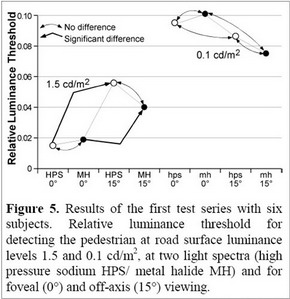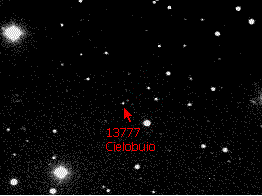Chi perora la causa interessata dei LED sostiene che a parità di luminanza di una superficie, questa viene percepita meglio dall’occhio umano se la sorgente ha forte componente blu come per i LED, piuttosto che con sorgenti a luce gialla tipo quelle al sodio alta pressione.
Risponde a questa affermazione lo studio indipendente di seguito riportato:
MESOPIC LIGHTING CONDITIONS AND PEDESTRIAN VISIBILITY
Jaakko KETOMÄKI, Marjukka ELOHOLMA, Pasi ORREVETELÄINEN, Liisa HALONEN – Helsinki University of Technology, Lighting Laboratory, Finland (2003-11)

La risposta è che in effetti è VERO, la luminanza di sorgenti a forte componente bianco-blu tipo LED è percepita meglio di quella di sorgenti al sodio.
PECCATO che questo avviene solo per luminanze inferiori a 0.1 cd/m2 che sono ben 5 volte inferiori al valore minimo di luminanza previsto per strade locali (ME5) (la maggior parte) e 10 volte inferiori al valore minimo per strade provinciali e statali (ME3), che complessivamente comprendono il 90% delle tipologie di strade.
Il grafico, che è solo il primo di una serie, evidenzia che non sussistono sostanziali differenze fra la percezione della luminanze con sorgenti al sodio ad alta pressione e a elevate componenti di luce blu.
Quanto sopra è evidenziato dalla figura 5 (tratta dalla pubblicazione in bibliografia) e dalle conclusioni della ricerca dell’Università di Helsinki di cui riportiamo un estratto:
In the mesopic luminance region both the rods and cones on the retina are active and this is believed to cause changes in the spectral sensitivity of the human vision. The objective of this work was to study the effects of light spectrum on visual performance in road lighting conditions. Mesopic vision involves both foveal and peripheral vision, which are based on different receptor combinations on the retina. In driving, a lot of information is gained from off-axis vision and peripheral vision becomes important. In this work visibility tests were made in experimental road lighting installations both for foveal and peripheral (15°/20°) viewing. Pedestrian visibility tests were carried out at two luminance levels (0.1/1.5 cd/m2) using high pressure sodium and daylight metal halide lamps. The results show that light level has a strong effect on visibility of moving targets. The effect of light level on visibility is not, however, linear in different parts of the visual field. Light spectrum did not affect visibility at either luminance level when the target was viewed foveally. This confirms our earlier findings, that V() is valid for assessing luminosity of foveal targets also at mesopic light levels. On the other hand, the results suggest that lamp spectrum has an effect on visibility in road lighting conditions in off-axis vision. At constant photopically i.e. V() weighted luminance levels, the lamps with high content in the blue wavelength region seem to be visually more effective than the conventionally used high pressure sodium lamps. This was, however, found only at the lower luminance level (0.1 cd/m2), where the contribution of rods is presumably higher than at the higher luminance level (1.5 cd/m2).





